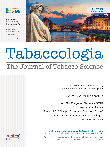|
Rassegna Stampa Scientifica Settembre 2021
Association between electronic nicotine delivery systems and electronic non-nicotine delivery systems with initiation of tobacco use in individuals aged < 20 years. A systematic review and meta-analysis PLoS ONE Published: September 8, 2021 Sze Lin Yoong ,Alix Hall,Heidi Turon,Emily Stockings,Alecia Leonard,Alice Grady,Flora Tzelepis,John Wiggers,Hebe Gouda,Ranti Fayokun,Alison Commar,Vinayak M. Prasad,Luke Wolfenden https://journals.plos.org/plosone/article?id=10.1371/journal.pone.0256044 Note: Open Access.
Related coverage:
"Serene Yoong, an associate professor at Swinburne University of Technology in Melbourne and the study’s lead author, said the findings pointed to the need for youth prevention programs and better regulation of e-cigarette products. “Every single study showed an association between [e-cigarette] use among non-smokers and increased use of cigarettes at follow-up,” she said… “Experimenting is not as benign as people might think in terms leading to later cigarette use,” Yoong said."
International research shows ‘strong evidence’ linking vaping to cigarette smoking
"Collagen-induced aggregation was higher in vapers compared to non-smokers (non-smokers 52.55 ± 23.97 vs. vapers 66.63 ± 18.96 AUC [area under the curve], p = 0.002) and to smokers (vapers vs. smokers 49.50 ± 26.05 AUC, p < 0.0001)… This study provides first evidence that vaping leads to enhanced platelet reactivity compared to standard smoking and non-smoking. This suggests health effects of vaping might be more severe than previously assumed."
Platelet reactivity is higher in e-cigarette vaping as compared to traditional smoking Int J Cardiol. 2021 Sep 7;S0167-5273(21)01325-5. Online ahead of print. Daniel Metzen, René M'Pembele, Saif Zako, Philipp Mourikis, Carolin Helten, Dorothee Zikeli, Samantha Ahlbrecht, Denis Ignatov, Aysel Ayhan, Ragnar Huhn, Tobias Zeus, Bodo Levkau, Tobias Petzold, Malte Kelm, Lisa Dannenberg, Amin Polzin https://www.internationaljournalofcardiology.com/article/S0167-5273(21)01325-5/fulltext
"268 experts were contacted, 92 (34%) completed the first, 55/92 (60%) the second round. Consensus for ENDS [electronic nicotine delivery systems]: components of e-liquids, an upper limit of nicotine concentration should be defined; a warning on the lack of evidence in long-term safety and addiction potential should be stated; ENDS should not be regulated as consumer products but either as a new category of nicotine delivery or tobacco products; ENDS should not be sold in general stores but in specialised shops, shops selling tobacco or in pharmacies with restriction on sale to minors; administration of illegal drugs is likely with ENDS."
International expert consensus on electronic nicotine delivery systems and heated tobacco products: a Delphi survey BMJ Open 2021;11:e045724. Online issue publication September 07, 2021 Ivan Berlin, Isabelle Jacot-Sadowski, Jean-Paul Humair, Jacques Cornuz https://bmjopen.bmj.com/content/11/9/e045724 Note: Open Access.
"As cannabis becomes increasingly integrated as part of a ‘wellness’ platform by multinational tobacco companies, questions continue about the suitability of having Big Tobacco—the producers of addictive and harmful products with a documented history of deceit and intentional marketing to vulnerable populations—oversee a supposed mission of ‘harm reduction’. The expansion of drugs that become fast-moving consumer products, sold by major and powerful global companies, needs careful evaluation. While tobacco industry denormalisation is regarded as an effective tobacco control intervention,29 tobacco companies are counteracting such measures and seeking to improve their corporate reputation by becoming associated with more legitimised and socially acceptable products."
‘Beyond nicotine’ marketing strategies: Big Tobacco diversification into the vaping and cannabis product sectors Tobacco Control Published Online First: 12 September 2021 Timothy Dewhirst https://tobaccocontrol.bmj.com/content/early/2021/09/11/tobaccocontrol-2021-056798
Also:
Interplay of food and tobacco product descriptors and health claims https://tobaccocontrol.bmj.com/content/early/2021/09/11/tobaccocontrol-2021-056831 Note: Interplay Editorial Open Access.
"When considering their US pack, approximately two-thirds of smokers had a low (31.5%) to medium (34.6%) positive response (reactivity=1.29; polarity=0.14) with expressed feelings of joy and trust. Blank packaging prompted a largely (65.4%) neutral response (reactivity=0.03; polarity=0.00). The gangrenous foot GWL [graphic warning label] provoked mostly medium (46.9%) to high (48.1%) negative responses (reactivity=−2.44; polarity=−0.20), followed by neonatal baby (reactivity=−1.85; polarity=−0.10) and throat cancer (reactivity=−1.76; polarity=−0.08) warnings. GWLs varied in their elicitation of disgust, anger, fear and sadness."
Role of affective reactivity induced by cigarette packaging including graphic warning labels: the CASA Study Tobacco Control Published Online First: 12 September 2021. Matthew Stone, David Strong, Claudiu Dimofte, Elizabeth Brighton, Jesica Oratowski, Tingyi Yang, Manar Alkuzweny, Atean Asslani, Katherine Velasco, Michael Skipworth, Noe C Crespo, Samantha Hurst, Eric C Leas, Kim Pulvers, John P Pierce https://tobaccocontrol.bmj.com/content/early/2021/09/11/tobaccocontrol-2021-056650
"The results showed that both emotion dysregulation and negative affect had indirect effects on urge to smoke via positive metacognitions about smoking as well as on nicotine dependence via negative metacognitions about smoking. The findings suggest that metacognitions about smoking have different roles in different patterns of nicotine use so that positive and negative metacognitions have important roles respectively in urge to smoke and nicotine dependence in smokers with high emotion dysregulation and negative affect."
The effects of emotion dysregulation and negative affect on urge to smoke and nicotine dependence: The different roles of metacognitions about smoking Addict Behav. 2021 Sep 3;124:107108. Online ahead of print. Hossein Poormahdy, Mahmoud Najafi, Vahid Khosravani https://www.sciencedirect.com/science/article/abs/pii/S0306460321002938
"This review provides a practical inspection of the current, international regulatory recommendations for abuse liability assessment of tobacco, regulatory review of such information within the U.S., and recommends study designs and methods for abuse liability testing of tobacco products based on scientific and regulatory knowledge."
Human Abuse Liability Assessment of Tobacco and Nicotine Products: Approaches for Meeting Current Regulatory Recommendations Nicotine & Tobacco Research, ntab183. Published: 09 September 2021 Andrea Vansickel, Sarah Baxter, Neil Sherwood, Michael Kong, Leanne Campbell https://academic.oup.com/ntr/advance-article-abstract/doi/10.1093/ntr/ntab183/6367135
Also:
New Zealand Smokers’ Perceptions of Tobacco Endgame Measures: A Qualitative Analysis https://academic.oup.com/ntr/advance-article-abstract/doi/10.1093/ntr/ntab161/6366500
"Smoking status, pack-years, and intensity of smoking were associated with hospitalizations in patients with COVID-19 and intensity of smoking was associated with ICU [Intensive Care Unit] admission. The findings underscore the need for detailed information beyond smoking status when evaluating smokers with COVID-19 so that the potential for adverse sequelae may be optimally managed in at-risk patients."
Assessment of Severe COVID-19 Outcomes Using Measures of Smoking Status and Smoking Intensity Int J Environ Res Public Health. 2021 Aug 25;18(17):8939. E Melinda Mahabee-Gittens, Angelico Mendy, Ashley L Merianos https://www.mdpi.com/1660-4601/18/17/8939
Also:
Tobacco Craving, Nicotine Dependence, and Quit Intentions among LGB and Non-LGB High School Students: A Quasi-Experimental Analysis https://www.mdpi.com/1660-4601/18/17/9000 Theory-Based Social and Non-Social Engagement Features in Smoking Cessation Mobile Apps: A Content Analysis https://www.mdpi.com/1660-4601/18/17/9106 Feasibility of a Smoking Cessation Smartphone App (Quit with US) for Young Adult Smokers: A Single Arm, Pre-Post Study https://www.mdpi.com/1660-4601/18/17/9376 Smoking Cessation Messages for Pregnant Aboriginal and Torres Strait Islander Women: A Rapid Review of Peer-Reviewed Literature and Assessment of Research Translation of Media Content https://www.mdpi.com/1660-4601/18/17/9341 Note: Open Access.
"This study uses regional-level panel data from the Monitoring the Future survey and a fixed effects model to estimate the effect of perceived risk on three regional measurements of smoking behavior: consumption, lifetime prevalence, and daily smoking prevalence. Elasticity measurements at regional levels show that an increase in perceived risk decreases these regional measurements of smoking behavior. Moreover, the results show that, at regional levels, these measurements of smoking behavior are more responsive to changes in the perceived risk associated with smoking than to changes in the price of cigarettes."
Regional Effects of Perceived Risks of Harm on Cigarette Smoking among U.S. High School Seniors: Evidence from Monitoring the Future Int J Environ Res Public Health. 2021 Aug 29;18(17):9120. Jorge Medina https://www.mdpi.com/1660-4601/18/17/9120
Also:
Parenting Styles as a Moderator of the Association between Pubertal Timing and Chinese Adolescents' Smoking Behavior https://www.mdpi.com/1660-4601/18/17/8903 Exposure to Secondhand Smoke: Inconsistency between Self-Response and Urine Cotinine Biomarker Based on Korean National Data during 2009-2018 https://www.mdpi.com/1660-4601/18/17/9284 Association between Self-Reported Survey Measures and Biomarkers of Second-Hand Tobacco Smoke Exposure in Non-Smoking Pregnant Women https://www.mdpi.com/1660-4601/18/17/9197 Implementation of the Department of Housing and Urban Development's Smoke-Free Rule: A Socio-Ecological Qualitative Assessment of Administrator and Resident Perceptions https://www.mdpi.com/1660-4601/18/17/8908 Note: Open Access. Public health impact of a US ban on menthol in cigarettes and cigars: a simulation study Tobacco Control Published Online First: 02 September 2021. David T Levy, Rafael Meza, Zhe Yuan, Yameng Li, Christopher Cadham, Maria Sanchez-Romero, Nargiz Travis1, Marie Knoll, Alex C Liber, Ritesh Mistry, Jana L Hirschtick, Nancy L Fleischer, Sarah Skolnick, Andrew F Brouwer, Cliff Douglas, Jihyoun Jeon, Steven Cook, Kenneth E Warner https://tobaccocontrol.bmj.com/content/early/2021/09/02/tobaccocontrol-2021-056604
Related PR:
Menthol ban would save 650,000 lives in the next 40 years https://medicalxpress.com/news/2021-09-menthol-years.html
"Roughly 14 % of students in the [Healthy Minds Survey] sample reported psychotic experiences over the past year, and around 14–15 % of students reported vaping over the past month. In multiple logistic regression models, vaping was significantly associated with psychotic experiences (aOR 1.88; 95 % CI: 1.63–2.18). This association attenuated but remained statistically significant even after adjusting for any cigarette use and marijuana use, and after adjusting for depression and anxiety."
Vaping and psychotic experiences among college students in the United States Drug and Alcohol Dependence Volume 227, 1 October 2021, 108987 Available online 1 September 2021. Hans Oh, Rachel Banawa, Jungeun Olivia Lee, Sasha Zhou, Jimi Huh https://www.sciencedirect.com/science/article/pii/S0376871621004828
Related coverage:
Vaping ‘significantly’ associated with psychotic experiences in U.S. college students: study
"Applying a continuous treatment difference-in-differences approach to data from two large national datasets (Monitoring the Future and the Youth Risk Behavior Surveillance System), this study explores the impact of ENDS [electronic nicotine delivery systems] taxes on youth tobacco use. We find that ENDS taxes reduce youth e-cigarette consumption, with estimated e-cigarette tax elasticities of -0.06 to -0.21. However, we estimate sizable positive cigarette cross-tax elasticities, suggesting economic substitution between cigarettes and e-cigarettes for youth. These substitution effects are particularly large for frequent cigarette smoking. We conclude that the unintended effects of ENDS taxation may more than fully offset any public health gains."
Intended and Unintended Effects of E-cigarette Taxes on Youth Tobacco Use NBER WORKING PAPER 29216 ISSUE DATE September 2021 Rahi Abouk, Charles J. Courtemanche, Dhaval M. Dave, Bo Feng, Abigail S. Friedman, Johanna Catherine Maclean, Michael F. Pesko, Joseph J. Sabia & Samuel Safford https://www.nber.org/papers/w29216
"The most common first-flavor [in a young adult cohort from Los Angeles, California] was sweet (71%); the most common first-device was a vape pen (37%), then Juul (22%). First-flavor of mint/menthol (vs. other; adjusted odds ratio [AOR]: 2.22[95%CI=1.16-4.25]), and first-device mod (AOR=2.40[95%CI=1.34-4.31]) and non-Juul pod (2.64[95% CI=1.41-4.92]) (vs. pen) were associated with past-30-day vaping, and twice as many vaping days (ARRs [Adjusted rate ratios] range: 1.96-2.12;ps<0.05). First flavor of mint/menthol (vs. other; AOR: 1.95[95% CI=1.003-3.79) and first device mod, box, non-juul pod and other (AORs range: 2.36-4.01;ps<0.05) were associated with nicotine dependence."
First e-cigarette flavor and device type used: Associations with vaping persistence, frequency, and dependence in young adults Nicotine & Tobacco Research, ntab172. Published: 30 August 2021 James D Sargent, Mike Stoolmiller, Hongying Dai, Jessica L Barrington-Trimis, PhD, Rob McConnell, Janet Audrain-McGovern, Adam M Leventhal https://academic.oup.com/ntr/advance-article-abstract/doi/10.1093/ntr/ntab172/6359789
Also:
Stability of varenicline concentration in saliva over twenty-one days at three storage temperatures https://academic.oup.com/ntr/advance-article-abstract/doi/10.1093/ntr/ntab173/6359791 What do people want in a smoking cessation app? An analysis of user reviews and app quality https://academic.oup.com/ntr/advance-article-abstract/doi/10.1093/ntr/ntab174/6359796 Newspaper coverage of snus in an emerging Norwegian snus market 2002-2011: A content analysis https://academic.oup.com/ntr/advance-article-abstract/doi/10.1093/ntr/ntab171/6360336
"Given the significant prevalence of e-cigarettes use and their pulmonary complications, EVALI [e-cigarette/Vaping-associated lung injury] should be considered a potential etiology in the broad differential diagnosis of patients with pulmonary disease and a history of vaping. Herein, we present a case of cryptogenic organizing pneumonia with a chest C.T. [computerized tomography] showing a crazy-paving pattern in a patient with a history of vaping."
Crazy vaping and crazy-paving, a case of E-Cigarette/Vaping-Associated Lung Injury (EVALI) with chest CT showing crazy-paving pattern Radiol Case Rep. 2021 Aug 26;16(11):3208-3212. eCollection 2021 Nov. Sherif Roman, Christopher Millet, Shady Geris, Rajapriya Manickam, Ashesha Mechineni https://www.sciencedirect.com/science/article/pii/S193004332100532X Note: Open Access.
"In this sample of MTurk [Mechanical Turk] workers, young adults with experience in vaping were more demographically and psychologically vulnerable than young adults with no experience in vaping. Young adults interested in vaping, but without prior experience, were less conscientious than their non-interested peers. Interventions to target vaping use should focus on economically disadvantaged young adults and those lower in conscientiousness."
Psychological and Demographic Predictors of Vaping and Vaping Susceptibility in Young Adults Front Psychol. 2021 Aug 17;12:659206. eCollection 2021. Grace E Teah, Tamlin S Conner https://www.frontiersin.org/articles/10.3389/fpsyg.2021.659206/full
Also:
Pictures Library of Smoking Cravings: Development and Verification of Smokers and Non-smokers https://www.frontiersin.org/articles/10.3389/fpsyt.2021.719782/full Note: Open Access.
"The majority of vapers succeeded in maintaining their vaping behavior as usual, highly likely due to (illegally) buying consumables online. Nevertheless, for a minority the lockdown period resulted in unintended consequences and these vapers relapsed (completely) to smoking. Even during periods of lockdown, smokers and vapers should be able to purchase low(er)-risk alternatives to smoking, for example e-cigarettes."
Vaping during the COVID-19 lockdown period in Belgium BMC Public Health. 2021 Sep 3;21(1):1613. Karolien Adriaens, Dinska Van Gucht, Sven Van Lommel, Frank Baeyens https://bmcpublichealth.biomedcentral.com/articles/10.1186/s12889-021-11637-4 Note: Open Access.
"The results suggest that COVID-19-related warnings elicit a similar level of negative emotional arousal, relative to traditional warnings. However, COVID-19 warnings, specifically, elicit especially strong emotional responses in less impulsive smokers, who report low delay discounting. Therefore, there is preliminary evidence supporting COVID-19 related warnings for tobacco products to aid smoking cessation."
Smokers’ Affective Responses to COVID-19-Related Health Warnings on Cigarette Packets: The Influence of Delay Discounting Nicotine & Tobacco Research, ntab176, Published: 01 September 2021 Chris R H Brown, Paul Faulkner https://academic.oup.com/ntr/advance-article/doi/10.1093/ntr/ntab176/6360730
Also:
Claims of reduced odor on tobacco packs in low- and middle-income countries https://academic.oup.com/ntr/advance-article/doi/10.1093/ntr/ntab177/6362730 Absolute and Relative Smokeless Tobacco Product Risk Perceptions: Developing and Validating New Measures that are Up-to-Snuff https://academic.oup.com/ntr/advance-article/doi/10.1093/ntr/ntab167/6364225 Note: Open Access.
"Twenty-six cohort and one case-control study were included in the final meta-analysis. We found elevated pooled risks of tobacco smoking initiation [RR = 2.08, (95 % CI: 1.18–3.68)], ever tobacco smoking [RR = 1.21, (95 % CI: 1.05–1.38)], current tobacco smoking [RR = 1.70, (95 % CI: 1.48–1.95)] and tobacco dependence [RR = 1.50, (95 % CI: 1.31–1.73)] in offspring exposed to maternal prenatal tobacco use compared to non-exposed."
|






















